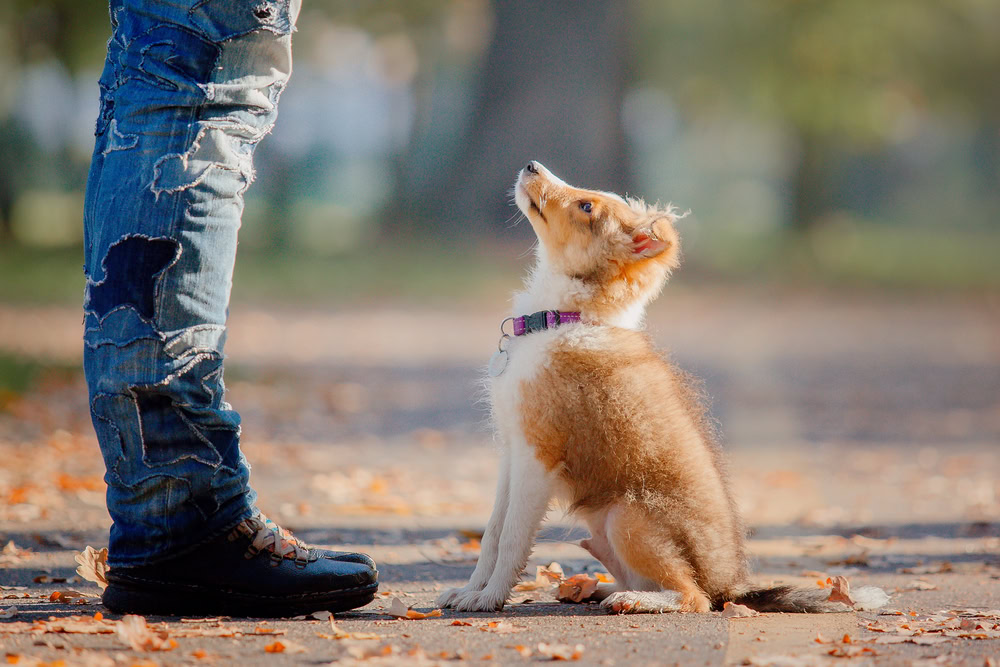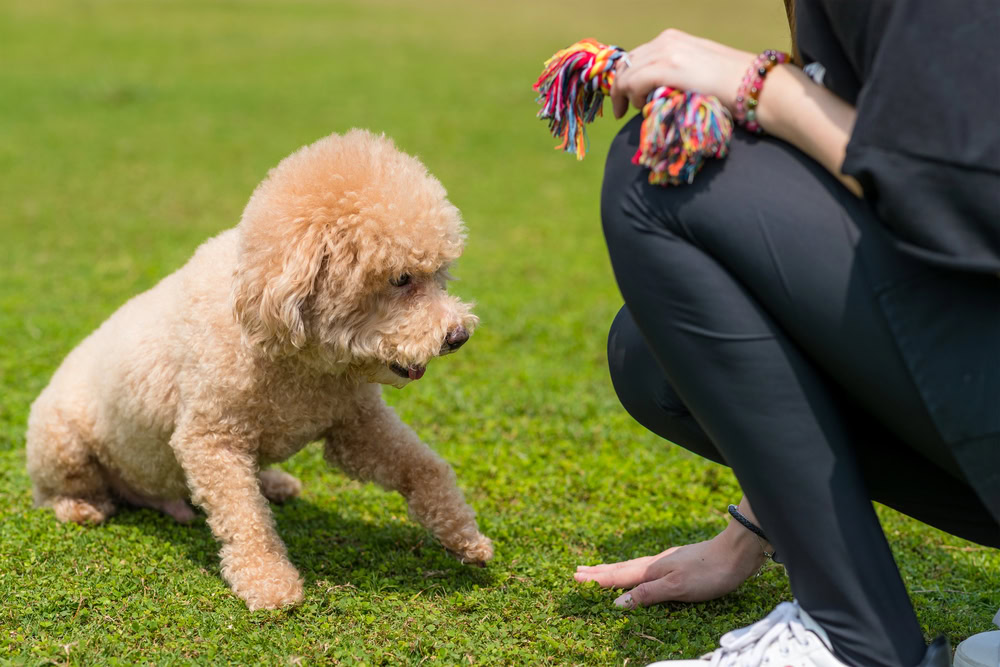You’ve brought a new puppy home, and now you’re faced with the vital task of training. While those adorable puppy eyes might tempt you to skip formal training, establishing essential commands early will shape your dog’s behavior for years to come. From preventing dangerous situations to creating harmony in your household, these fundamental commands serve as building blocks for advanced training and daily life management. Whether you’re a first-time owner or experienced with dogs, understanding the right approach to these basic commands can make the difference between a well-behaved companion and a challenging pet.

Mastering the “sit” command opens up the foundation for all future puppy training. As one of the first commands you’ll teach your puppy, it’s essential for developing advanced obedience skills and managing social situations effectively.
You’ll find that a reliable sit command makes everyday life with your puppy more enjoyable and controlled.
To teach your puppy to sit, hold a treat above their head and slowly move it backward. As your puppy follows the treat with their nose, they’ll naturally lower their bottom to the ground. When they sit, immediately praise and reward them.
Training for 1-1.5 hours daily but 10-15 minutes at a time will help establish this crucial command. Repeat this process while adding the verbal cue “sit” until your puppy makes the connection between the word and action.
Don’t rush the training process or skip steps. Keep sessions brief and engaging, and avoid using a harsh tone that might frighten your puppy.
You’ll want to practice in different environments and gradually increase distractions. Start phasing out treats once your puppy responds consistently, replacing them with praise and occasional rewards.
Remember to remain patient and consistent with both your verbal cues and hand signals throughout the training process.
The stay command is your crucial control tool for keeping your puppy safe and well-behaved in various situations. To teach it effectively, start with your puppy in either a sit or down position. Give a clear hand signal, say “stay,” and immediately reward your puppy with a treat before they move. Introduce a release word like “OK” or “free” to signal when they can break the stay.
Begin with short durations, rewarding your puppy while they maintain the position. Once they’ve mastered brief stays, gradually increase the time between treats and start adding distance by taking one step back. Using a mat can help your puppy understand their designated spot, making the training more concrete. Consider using a tether for high-energy puppies to maintain better control during initial training sessions.
Keep your training sessions brief but frequent, and always practice in areas with minimal distractions at first. As your puppy improves, slowly introduce new environments and challenges.
Remember to maintain consistency with your verbal cues and hand signals. You’ll want to integrate stays into daily routines, like waiting at doorways or before meals, to reinforce practical applications of this crucial command.
Teaching your puppy to come when called builds on the trust and control you’ve established with the stay command. Start training in your backyard or another low-distraction area, where you’ll first call your puppy using only its name. Once your puppy responds consistently, add the word “come” immediately after its name, rewarding with treats when it reaches you.
After a week of successful basic training, move to environments with moderate distractions using a long training leash. Let your puppy become interested in something, then call it using both name and command. When it responds, praise enthusiastically and offer treats, then allow it to return to its activity. This teaches that coming to you doesn’t always end the fun. This command is especially important as it can help keep your puppy safe in potentially dangerous situations.
Make training engaging by incorporating games like “Hide and Seek” or “Ping Pong Recall.” You’ll want to practice in various locations where you’ll commonly use the command. Gradually increase both distance and distractions as your puppy improves.
Confirm all family members use the same approach to reinforce consistent behavior. Remember to keep your puppy on a leash during early training sessions until recall becomes reliable.
Successful leash training begins with proper harness and collar introduction, which forms the foundation for your puppy’s walking habits. Let your puppy wear the collar or harness for short periods indoors, allowing them to drag the leash under your supervision. Use treats and playful interactions to create positive associations with the equipment. Keep initial training sessions brief, typically 5-10 minutes, to maintain your puppy’s engagement and focus.
Once your puppy’s comfortable with the gear, start teaching them to come to you while on leash. Guide them into position using treats and praise, practicing a few steps at a time in a distraction-free indoor environment. You’ll gradually increase the walking distance and duration as your puppy gains confidence.
Focus on teaching your puppy to heel on one consistent side. Use food lures to maintain their position and practice turns to build their directional awareness. As they improve, incorporate verbal commands and hand signals while slowly introducing more challenging environments.
Advance your training by walking in different locations with varying levels of distraction. When your puppy pulls, step back and change directions and when the puppy comes back to your side, reward with a treat. Remember to maintain consistent rewards for good behavior, using both treats and verbal praise to reinforce proper leash manners.
While mastering leash skills builds a strong foundation for walks, training your puppy to “leave it” adds another layer of safety to your daily adventures. This essential command can prevent your puppy from ingesting harmful substances, chasing dangerous animals, or approaching unsafe situations.
Start by keeping a high-value treat in one hand and a lower-value treat in the other. Place the low-value treat in your closed fist, letting your puppy sniff it. When they stop trying to get the treat, say “leave it” and reward them with the high-value treat from your other hand.
Once they’ve mastered this step, place treats on the floor just out of reach, gradually increasing the challenge. Remember to keep sessions short to maintain your puppy’s focus and engagement.
You’ll want to practice this command in various environments and with different items. Begin in quiet areas, then progress to more distracting settings. Always reward your puppy consistently for correct responses, using treats they find especially motivating.
As your puppy improves, introduce more challenging scenarios like rolling treats across the floor or placing them in more accessible locations. This progression guarantees they’ll respond reliably when it matters most.

Training “down” and “wait” commands can transform your boisterous puppy into a well-mannered companion.
When teaching “down,” start by holding a treat close to your puppy’s nose, then slowly guide it toward the ground. Your pup will naturally follow the treat, eventually lying down. Once they’re in position with their chest, elbows, and hocks touching the ground, reward them immediately with the treat and praise. If they won’t lay down you can guide them down by gently pushing on the shoulder blades as you lure them down with the treat. Keep training sessions short and focused, lasting only 5-10 minutes at a time.
To master the “wait” command, begin with your puppy in a sitting position. Hold a treat above their head, but don’t give it right away. You’re teaching them to pause and show self-control. Start with brief waiting periods, then gradually extend the duration.
Practice this command at doorways, only releasing your pup with an “okay” when they’ve shown patience.
For both commands, you’ll want to practice in different locations and slowly add distractions. Remember to introduce the verbal cues while performing the actions.
These commands aren’t just about obedience - they’re essential tools for helping your puppy learn self-control and calm behavior in various situations.
Building on the foundation of down and wait commands, your puppy’s next step is mastering the “watch me” or focus command. This vital skill teaches your puppy to give you their undivided attention, which becomes essential for obedience training and managing behavior issues.
Start training in a quiet area with minimal distractions. Say your puppy’s name followed by “watch me,” and immediately reward them with treats when they make eye contact. Say, “good watch” the exact moment of eye contact for faster learning. Keep these initial sessions short and engaging. Try hiding treats behind your back to encourage sustained attention.
As your puppy improves, gradually increase both the duration of focus and the level of distractions. You’ll want to practice in different environments, but only move to more challenging situations when they’re consistently successful at the current level.
Make yourself engaging and fun during training sessions, as you want to become your puppy’s primary source of rewards and entertainment.
Remember to maintain consistency in your training approach and reward schedule. Practice regularly, but keep sessions brief to prevent your puppy from becoming overwhelmed or losing interest.
Through patient repetition, you’ll develop a reliable focus command that serves as a foundation for advanced training.
A puppy’s journey into obedience begins with mastering simple commands like sit, down, stay, come, and heel. Short training sessions of 10-15 minutes at a time will help maintain your puppy’s interest and focus.
Start with “sit” by standing in front of your puppy and holding a high-value treat above their head until they naturally sit to view it. Reward immediately to reinforce the behavior, and gradually phase out the lure in favor of verbal commands.
Once your puppy masters “sit,” move on to “down” by using a treat to guide them from a seated position to the ground.
For “stay,” begin with your puppy in a sitting position, take one step back, and reward them for remaining in place. Gradually increase the distance and add distractions to strengthen their response.
Teaching “come” and “heel” requires consistent practice and positive reinforcement. Use your hand as a target for “come,” and when teaching “heel,” keep your puppy on your left side while guiding them with treats.
You’ll need to practice these commands for 1-1.5 hours daily, five days a week, in various environments to guarantee reliable responses in all situations.
Establishing strong training foundations requires a deep understanding of positive reinforcement and consistent routines.
You’ll need to focus on creating short, structured training sessions that keep your puppy engaged while building trust through reward-based methods. Using treats, praise, and play, you can motivate your puppy without causing stress or fear.
Having a collection of high-value puppy treats will make training more effective and motivating. Start by implementing early socialization and foundation skills like name recognition.
Keep your training sessions brief but frequent, as this approach proves more effective than lengthy, irregular sessions. You’ll want to use clear, consistent commands and hand signals to reduce confusion and speed up the learning process.
As your puppy masters basic commands, gradually reduce rewards while maintaining motivation. Your training routine should adapt to your puppy’s age and learning pace while progressively introducing more complex commands.
Remember that consistency is vital in every aspect of training.
When you maintain regular sessions and clear communication, you’ll strengthen your bond with your puppy while creating a solid foundation for advanced training later on.
You’ll find that investing time in teaching your puppy these essential commands pays off throughout their life. By starting early and staying consistent, you’re building a well-behaved companion who responds reliably to your cues. Remember, every training session strengthens your bond, and as your puppy masters these basics, you’re setting them up for success in more advanced training ahead.